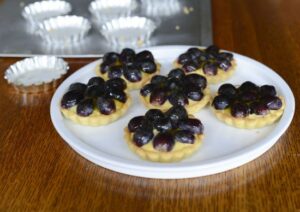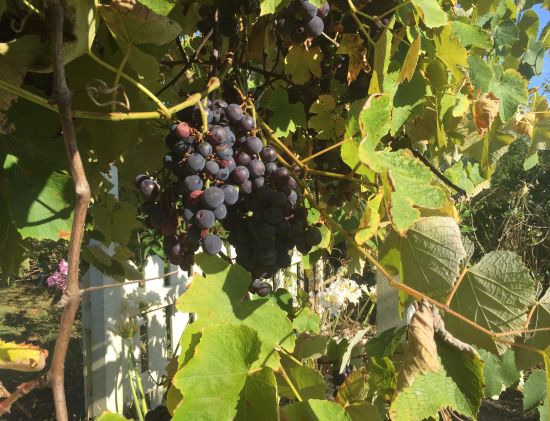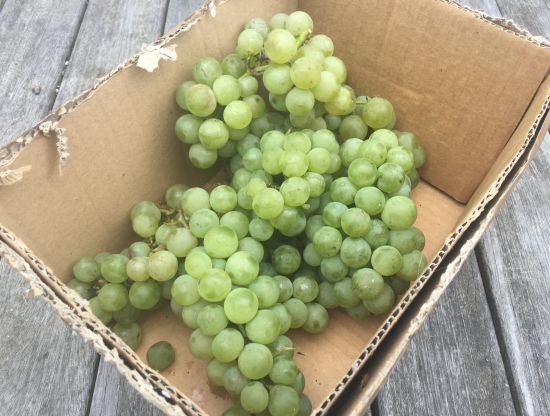
Table grapes are larger than wine grapes with thicker pulp and thinner skins.
Plant young grape plants in autumn in milder areas or early spring in colder climates. Grape varieties grown in containers can be planted up until early summer.

Table grapes are larger than wine grapes, often seedless, with thicker pulp and thinner skins.
Plant young grape plants in autumn in milder areas or early spring in colder climates. Grape varieties grown in containers can be planted up until early summer.
Find a site that has good drainage and as much sun as possible. Full sun helps develop sweet, full-flavoured fruits. Air circulation is vital to preventing disease, and the plants will need some protection from strong winds. They can tolerate some salt.
Grapes will grow in almost any conditions unlike most other fruiting crops. They’re not fussy at all. They only thing they don’t like is getting water-logged. The roots of grape vines go deep into the earth where they source nutrients and water.
Grapes should be planted with a durable growing structure (a fence or wall with wires, an arbour, or a simple post and wire trellis) installed at planting time. After planting grapes, water them thoroughly and mulch with well-rotted compost or manure. Grapes don’t need extra water, except during drought but they may benefit from being watered during fruit swell.
Most grapes will produce a healthy crop from just one vine—they don’t need a pollinator. A single grapevine can also scramble up an arbour and provide leafy green shade all summer.
When choosing grape varieties, start by looking for those that are disease-resistant — and in almost every case, that means growing grapes with seeds. Seedless varieties have not been bred with disease resistance as a priority. Also choose a variety that suits your climate.
Grapes are not nutrient hungry. Young plants only need one application in early spring of a balanced complete fertiliser like Natures Organic Fertiliser. Older plants only needed feeding if you see a deficiency.
Cover the vines with netting if you don’t want to share your harvest with the birds.
Keep pests in check by planting an insectary including yarrow, catmint, echinacea and penstemon to attract beneficial insects.
Powdery mildew can weaken plants and reduce grape flavour. Preventive sprays of 1-part-milk to 5-parts-water can minimise this problem.
Black rot can be controlled by removing all old, dry and diseased fruit as it overwinters on infected fruit and stems. Prune all infected stems and sterilise your secateurs between cuts by dipping them into methylated spirits.
Bunches of grapes can be thinned on a regular basis to encourage larger berries. Use nail scissors or special grape scissors to remove misshapen and diseased grapes. After the berries get to pea-sized, continuing removing grapes until the rest grow to a good size.
Grapes are ripe and ready for picking when they taste sweet. They won’t ripen further after harvest. Allow grapes to stay on the vine until the berries show a whitish bloom on their skins, but bring them in if you think wet weather is on the way. Ripe grapes often crack after heavy rains. Keep clusters of unwashed grapes in the refrigerator, stored in plastic bags to help retain humidity.

Grapes need pruning more than any other fruiting species. If the vines aren’t pruned and trained you’ll get irregular or poor crops. It’s best to prune before the leaves emerge, some time in mid-late winter. All grapes produce fruit on one-year old wood. That means the growth produced during the previous year will produce fruit for the coming season. After planting, don’t prune at all during the first full year. Having abundant stems and leaves will help develop a strong root system on immature grape vines. In the second year, select the strongest and most vigorous stem that developed during the first season. Remove everything else from the plant as close to the base as possible. Stake the one remaining stem to provide support. This stem will become the main trunk of the vine. Pinch the top of the main stem to encourage side growth. After the second year, select two of the best looking stems that are growing horizontally from the main trunk. Ideally they should be on opposite sides and about the same height on the trunk. Remove all other side growth. By the end of the second year, you should have a plant that looks like a ‘T’. This is now the basic frame of the vine. In following years, growth will form on the arms of the ‘T’. Leave 10 to 12 buds along each arm and remove all other growth along the main trunk. The buds will produce fruit, and every year thereafter should be pruned down to 1 or 2 new buds on each of twelve on the ‘T’.
Grapes are at the centre of a phenomenon known as the French Paradox, where the French, who tend to eat higher levels of animal fats than people in many other countries, have a lower incidence of heart disease. It’s now thought the reason could be the greater consumption of red wine in France. Something in the grape helps to lower cholesterol levels in the body and thus slows the buildup of deposits in the arteries. Compounds such as resveratrol (a polyphenol antioxidant) have been discovered in grapes and these have been positively linked to fighting cancer, heart disease and degenerative nerve disease and other ailments. Three or four glasses of red wine a week is thought to be beneficial!
Website designed by www.thecornerstorecollective.com
Developed by Richard Hpa